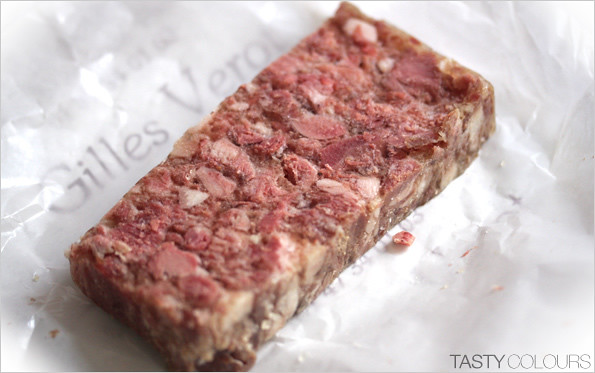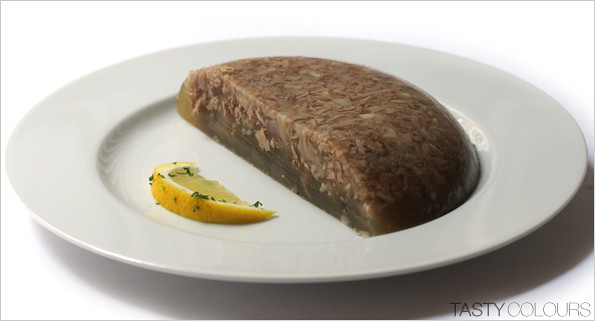I like meat, but I like good quality meat first of all. If I do not have the access to good meat, I simply prefer to cook vegetarian dishes or eat fish.
My childhood occurred in the middle of the seventies and eighties. In communist Poland the food market was regulated of course. Meat, especially good meat, was practically not accessible in state’s owned shops. And in the eighties, during the ever-lasting crisis, I remember my parents and me spending hours in lines to buy meat of poor quality.
After I was born, the first food regulations and ration stamps were introduced in 1976. They concerned sugar supplies. Then in 1981 the Government introduced other numerous limitations: meat, butter, kasha, rice, flour, oil, soap, cigarettes, sweets, alcohol and gasoline were regulated and sold in exchange of ration stamps. But despite those regulations, shops were usually empty and lines in front of them were endless. At the same time the Government was increasing prices of food and other goods.
On the other hand, informal distribution channels existed and it was not especially difficult to buy meat, even on a food market (for example, Kleparz in Kraków), from individuals and farmers. As regards my family, we occasionally had some supplies from the countryside. Two or three families were buying a quarter or a half of a calf and shared its meat. And yet, we used to spend a lot of holidays in the countryside. We boarded at private cantinas maintained by local farmers, where meat was served on a daily basis.
All in all I can say that in our home we did not lack any meat, although to get it required much effort from my parents.
Today, more than 20 years after the change of political system, everything has changed. In general meat is accessible; however paradoxes still exist. The percentage of poor people in Polish society is still high. In some regions of the country it is difficult to buy veal, for example, as it simply is too expensive and people cannot afford it. On the other hand, production of “industrial” chicken developed so much that one can have difficulties finding chicken meat from the countryside. And, in general, you will not easily find meat from ecological farms in Poland. It is not so easy either to buy fresh duck, or goose (as far as I know most of the Polish goose production is exported, for example) - you will rather buy them frozen when you actually can find them in some shops. Further, lamb meat is not so common; during my last visit to Kraków I had an impression that it was easier to get lamb meat from New Zeland than from Poland. Still, even cheaper rabbits are not so easy to find. Moreover, traditional butcher shops tend to disappear.
That’s why since I have been living in France, I really appreciate to have access to such a large variety of meat. And moreover, fortunately, we have here Monsieur Bajon, located rue de l’Abbé-Grégoire, an excellent traditional butcher. He sells meat of excellent quality and you can always order anything you wish. He is not cheap, but not exceptionally expensive by Parisian standards, of course. On the other hand, as I already indicated, I prefer to eat good meat once in a while instead of bad meat every day.
Meat is not the only thing I like from animals. Besides brains, which I do not like, I really enjoy offal such as tripe, veal’s thymus, beef’s tongues, jelly preparations and other nasty things, even a liver!, although it is true that I do not eat them so often.
My favorite dish of that type is homemade jelly from pig trotters and veal.
It is a very old fashioned dish and time consuming to prepare. Jellies are popular in Poland, but those you can find in stores are made with processed gelatin and have a poor taste: they do not have this rich flavor obtained by a long cooking process which naturally retrieves the gelatin from the bones. Moreover, in stores you will rather find jellies with chicken meat produced in huge farms that I find quite tasteless.
In France, people used to eat jellies as well. This kind of preparation seems to be old fashioned, and is not so popular anymore. But some traditional and renowned traiteurs are still famous for them and have a faithful clientele who buys them. For example, I recently had a quick look at Gilles Verot, the famous traditional charcuterie located at the beginning of rue de Notre-Dame-des-Champs.
Giles Verot is well known in Paris, inter alia, thanks to his traditional “fromage de tête”, which simply is a meat jelly made with meat from the head of a pig. In France, Verot was elected champion in this field, and the information is proudly displayed on the front of his shop. For a certain time now, Verot’s charcuterie products can also be found in New York City, in the trendy Bar Boulud on Broadway.
I have tried this famous fromage de tête, as I love meats in jelly. It surprised me. Well, I found that both the meat (which was of good quality) and the jelly were actually quite salty, much more than I am used to. The texture was nice, firm as I like it, the presentation excellent. It was good… but all in all I must admit that I prefer the rustic jelly that my Mum prepares. The experiment with Verot’s famous fromage de tête brings me to the conclusion that despite our culinary experiments and good sentiments for foreign culinary traditions, we are very strongly attached to our individual tastes from childhood.
My mum masters the preparation of an excellent jelly made from pigs trotters cooked for hours with spices and veal meat. She does not use any extra gelatin, as the pigs trotters have a lot of natural one. Her recipe is full of meat, spices, with a slight garlic aftertaste, and has a funny texture that I like. It is firm enough but not too hard. Simply delicious. I am sharing here with you this recipe:
Veal in Pig’s Trotter Jelly
Serves 10-12
Ingredients:
2 kg raw, non salted pig’s trotters (around 4 pieces), cut into halves
600 g good quality veal for stew
3 bay leaves
10 grains black pepper
10 grains allspice
1 small leek (around 150 g), only the white part, washed
1 medium carrot, peeled and washed
1 medium parsley root or parsnip, peeled and washed
¼ medium celery root (around 150 g), peeled and washed
1 big onion, peeled, cut into halves and slightly grilled (on
gas stove or on a frying pan)
8 large garlic cloves, peeled and mashed in a mortar
3-4 tablespoons chopped parsley
Salt
Pepper
4-5 lemons
Large saucepan (5 liter capacity)
2 large bowls, around 2 liter capacity
Preparation:
Boil 2 liters of water, place pig’s trotters in a large saucepan and parboil them for 2 minutes.
Strain and throw the water away.
In the same saucepan, bring to a boil around 3 liters of water.
Add pig’s trotters.
They should be completely covered by water.
Add spices: pepper, bay leaves, allspice and onion.
Cook under cover over a very low flame for around 4 to 5 hours.
By the end of cooking, the trotters should to go into pieces.
After 3 hours of cooking, add veal meat cut into two equal slices.
Bring to a boil and lower the flame.
The meat has to be slightly covered by the broth (if necessary, add a bit of boiling water to cover it).
Cook nearly completely covered (leave a small space to evaporate the eventual excess of broth).
It is really important to control the amount of broth: if there is too much of it, you risk that the jelly will not set well; on the contrary, if the broth evaporates too much, you will not have enough broth and the jelly will be too hard.
After 4 hours of cooking, add vegetables: leek, carrot, parsley, celery and half of the garlic cloves.
Cook between 40 minutes and one hour, over a low flame and nearly completely covered, checking occasionally the volume of the broth and its thickness.
5 minutes before the end of cooking (the broth should be thick and the veal should be really soft), add remaining garlic; season with salt and pepper. Then turn the heat off and put aside.
Prepare two strainers: one, big to separate the meat and vegetable from the broth and the second one (the best is a chinois) to strain the broth and remove smaller solids.
Using the larger strainer, strain the broth. Only throw away the vegetables and put the rest aside, to cool down a bit. Reserve the broth!
Strain the broth again using the chinois. Throw away all leftovers. Put the broth aside. The purpose of the second straining is to ensure that the jelly with have a nice color and will remain transparent.
Then prepare the meat: cut the veal into very thin and small pieces, along fibers.
As regards pigs trotters, remove all bones and throw them away. Throw away the skin and the greasy parts as well. If there is any meat, add it to the veal meat. And if you like cartilage, you can add little bits of it cut into tiny pieces.
Depending how you want to serve the jelly, you can either distribute the meat equally into several tiny bowls or between 2 large bowls only. Whichever method you choose, always distribute equal quantities of meat into each bowl and pour an equal amount of broth over it. Mix delicately.
Once the liquid has cooled down, cover the bowls with a plastic film and place them in a fridge overnight, so the jelly can set.
On the next day, remove the bowls from the fridge and remove the excess of fat from the surface of the jelly (provided that you do not like it).
Before serving, unmold the jelly from the bowl and serve it cut into slices (once the jelly is solid it is rather easy to unmold and slice).
I serve this dish with quarters of fresh lemon, sprinkled with some fresh, chopped parsley. You can also serve it with a good wine or cider vinegar.
Consume within 3 days because jellies cannot be kept for a long time.











11 comments:
I have a childhood trauma with pigs' trotters jelly. :( Yours looks tasty and I believe it contains meat that I would like, but stil remember my Granny's jelly - it was very fat.
Okay then... I’ve decided to write something in English but probably won’t do this again :) Must say that my Mum makes the best jelly ever. She makes it in exactly the same way as you did but it’s slightly different than yours. It doesn’t contain celery and leek but it’s always made from pig’s trotters, whole chicken and a good quality beef. It’s both really rich and light and tastes absolutely fantastic! My Mum serves it in the small bowls – on the bottom you can find some garden peas, carrots slices and meat (both taken out from the broth).
Anyway your recipe is fantastic and I will use it for sure!
Cheers Magda!
Polka
Bardzo dobry wpis.
Ostatnio rozmawiałem z babcią o cielęcinie. Babcia przepracowała w masarni ponad 30 lat, mieszka na wschodzie (koło Lublina). Stwierdziła, że cielęcina jest tam praktycznie niedostępna. W Warszawie jest lepiej.
W kwestii jagnięciny za to, o której piszesz, ta z Nowej Zelandii stanowi w Polsce podobno prawie cały rynek jagnięciny (nie pamiętam liczby ale wydaje mi się, że 90%).
Słyszałem ciekawostkę o rynku mięsnym w Szwajcarii. Podobno podaje się często mięso kangurze bo jest tańsze niż wiele innych rodzajów.
Traditional butcher shops tend to disappear - sad, sad, sad! i ciężko ten proces nawet wytłumaczyć. Podobnie jest teraz z piekarniami w Polsce. W Warszawie w większości "dobrych piekarni" wypieki przygotowuje się jednego dnia, najczęściej w niedzielę i mrozi. W każdej piekarence z sieci jest piec elektryczny i świeże, tj. odmrażane pieczywo jest sprzedawane. Przerażające!
Kurczaki zalały cały mięsny rynek drobiu. W Polsce nie ma tradycji dobrego jedzenia, jest za to tradycja obżarstwa- tym sobie tłumaczę te wszystkie anomalie.
ps. jeśli nie stanowi dla Ciebie różnicy kwestia wyświetlania pola do komentarzy, mam jedną sugestię do blogu. Wygodniej jest ustosunkować się do tekstu, kiedy okno do komentarza wyskakuje jako dodatkowe.
pozdrowienia serdeczne!
ps.' czytałem kiedyś ciekawy artykuł o mięsie w restauracjach w Polsce (i nie tylko mięsie)... szukam... jest - http://wyborcza.pl/1,99219,6657509,Wasze_ciala_to_wesole_miasteczka.html
znałaś?
I have never tried my hands at serious charcuterie, except for pates, and an ocassional string of white sausages, prepared together with my granny.
It is true what you say about veal. Almost the rarest delicacy these days, it is perhaps easier to find caviar in shops than this meat. I guess we have to wait for the advent of industrialised "chicken-like" methods of calf production. Maybe cloning is the answer?
cacy:)
przyjemnego weekendu!
Karolina, sorry for your childhood trauma, one cannot like everything. This jelly is not greasy at all :) It is a pleasure to taste it, provided one loves that type of food. Take care !
Thanks Polka. Feel free to comment in your preferred language; however, I think your English is very good! Recipes for homemade jellies vary from family to family - as regards the types of meat, ingredients, spices, vegetables. This proves that those traditional preparations are really different, while the method of the preparation remains the same (retrieving the gelatin from the bones). My jelly is “gone with the wind” already.
Hello, Kucharz! How are you after your holidays? Fine already? I hope that you rested well and that you are full of energy. I am not so convinced that cloning is an answer to the situation with veal meat in Poland. You must be kidding…as far as I know you! I believe if society was richer, in general, the demand for better meat in the provinces would be greater.
All in all, I prefer a good pork than to bad chicken. Have a good weekend!
Mich. Dzieki za uwagi. Zaczne OT- zmienilam juz ustawienia okienka do puszczania komentarzy, myslalam o tym wczesniej, ale do tej pory nie moglam sie zebrac, zeby poprawic to i owo w ustawieniach.
Nie mam babci pracujacej w masarni, ale to m inn z forow kulinarnych dowiedzialam sie, ze lepsze gatunki miesa tzn w tym przypadku cielecina, sa ciezko dostepne nawet w wiekszych prowincjonalnych miastach (tzn takich powyzej 100 tysiecy). Ciezko jest z krolikami, ktore przeciez nie tak dawno hodowalo sie w ciezkich powojennych czasach na podworkach (a moze wlasnie dlatego nie sa popularne?). Rynek drobiowy jest zatrwazajacy, uswiadomilam to sobie po raz kolejny podczas ostatnich wakacji w Krakowie, gdy poszukiwalam dobrego drobiu dla naszej rocznej corki. Nie bylo to latwe przedsiewziecie.
Zastanawialam sie z mezem przy okazji pisania postu, dlaczego w Polsce (a przynajmniej w Krakowie) nie ma takich panow „Bazantow” (jak nazywam tego paryskiego rzeznika, o ktorym pisze), ktory jest artysta w swoim zawodzie. To nie tylko rzeznik, a cala instytucja, ktora doradzi jak piec, smazyc, w jakiej temperaturze, ile czasu, ktora wykroi piekne i rowne kotleciki, odkroi delikatnie, ale pewna reka zbedny tluszcz, tak aby nie zniszczyc faktury miesa. Doszlismy do wniosku, ze to byc moze wskutek komuny upadla sztuka rzeznicza (nie zawod). Wielka szkoda, ze rowniez rynek wedliniarski w naszym kraju kiepsko sie przedstawia pod wzgledem jakosci. Tacy rzemieslnicy, jak np Stanislaw Madry z Liszek, ktory robi wyjatkowa (i prawdopodobnie jedyna slowfoodowa kielbase lisiecka) funkcjonuja w Polsce czesto poza obrotem detalicznym. I niestety malo jest piekarni wytwarzajacych prawdziwy chleb, a pelno sieciowek wytwarzajacych „tradycyjny” chleb na chemicznym „zakwasie”. I mozna by tak jeszcze pisac o mleku UHT, homogenizowanej smietanie, masle z dodatkiem tluszczow roslinnych...serach zoltych z dodatkiem oleju...niestety to temat na odrebny post, a nie komentarz.
Nie wiem, czy mieso kangurze jest tansze we Francji – jadlam je kilka razy, gdy mieszkalam w Strasbourgu, ale w knajpie typu „wok”, natomiast tutaj tego miesa nigdzie nie widzialam. Sytuacji z jagniecina kompletnie nie rozumiem, wielka szkoda, ze tak ciezko i takie drogie jest to mieso, oraz ze ma zla reputacje.
Dzieki za namiary o artykule o miesie w restauracjach,zaraz zabieram sie do czytania. Pozdrawiam!
Living in the US i miss this so much, thank you so much for a recipe!
Delishhh: thanks for visiting blog....does it mean you have Polish roots?
Magdalena, the part about food rationing sounds all so familiar, as well as informal and offical ways of food sourcing during the Soviet era!!!
Brawn (sült) is very popular in Estonia as well, and I love it!!! (if made well, of course).
Pille,
I wonder whether food rationing in Estonia, which was a part of the USSR "empire" for so many years, was worse than in other ex-soviet republics?
Thanks for visiting!
Post a Comment